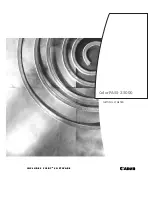
• Heavy equipment–personal injury or equipment damage might result if mishandled.
• Always lower the leveling pads on the rack cabinet.
• Always install stabilizer brackets on the rack cabinet.
• To avoid hazardous conditions due to uneven mechanical loading, always install the heaviest
devices in the bottom of the rack cabinet. Always install servers and optional devices starting
from the bottom of the rack cabinet.
• Rack-mounted devices are not to be used as shelves or work spaces. Do not place objects on top
of rack-mounted devices.
• Each rack cabinet might have more than one power cord. Be sure to disconnect all power cords in
the rack cabinet when directed to disconnect power during servicing.
• Connect all devices installed in a rack cabinet to power devices installed in the same rack
cabinet. Do not plug a power cord from a device installed in one rack cabinet into a power device
installed in a different rack cabinet.
• An electrical outlet that is not correctly wired could place hazardous voltage on the metal parts of
the system or the devices that attach to the system. It is the responsibility of the customer to
ensure that the outlet is correctly wired and grounded to prevent an electrical shock. (R001 part 1
of 2)
CAUTION:
• Do not install a unit in a rack where the internal rack ambient temperatures will exceed the
manufacturer's recommended ambient temperature for all your rack-mounted devices.
• Do not install a unit in a rack where the air flow is compromised. Ensure that air flow is not
blocked or reduced on any side, front, or back of a unit used for air flow through the unit.
• Consideration should be given to the connection of the equipment to the supply circuit so that
overloading of the circuits does not compromise the supply wiring or overcurrent protection.
To provide the correct power connection to a rack, refer to the rating labels located on the
equipment in the rack to determine the total power requirement of the supply circuit.
• (For sliding drawers) Do not pull out or install any drawer or feature if the rack stabilizer
brackets are not attached to the rack. Do not pull out more than one drawer at a time. The rack
might become unstable if you pull out more than one drawer at a time.
• (For fixed drawers) This drawer is a fixed drawer and must not be moved for servicing unless
specified by the manufacturer. Attempting to move the drawer partially or completely out of
the rack might cause the rack to become unstable or cause the drawer to fall out of the rack.
(R001 part 2 of 2)
Important: In addition, remember:
• The rack design must support the total weight of the installed enclosures and incorporate stabilizing
features suitable to prevent the rack from tipping or being pushed over during installation or normal
use.
• The rack must not exceed the maximum enclosure operating ambient temperature of 35-degrees C
(95-degrees Fahrenheit). Air is drawn through the control enclosure by fans in each node canister and
each power supply.
In particular, the rack front and rear doors must be at least 60% perforated to enable sufficient airflow
through the enclosure. If there is less airflow, additional mechanisms are required to cool the
enclosure. An appropriate IBM rack configuration would be the 7014-T42 IBM Rack Model T42, with
standard rear door and feature code 6069 Front Door For 2.0 Meter Rack (High Perforation).
8 SAN Volume Controller 8.3.1: Machine Types 2145, 2147 Models SA2, SV2
Summary of Contents for SAN Volume Controller 2145
Page 1: ...SAN Volume Controller 8 3 1 Quick Start Guide Machine Types 2145 2147 Models SA2 SV2 IBM...
Page 4: ...iv...
Page 6: ...vi SAN Volume Controller 8 3 1 Machine Types 2145 2147 Models SA2 SV2...
Page 32: ...12 SAN Volume Controller 8 3 1 Machine Types 2145 2147 Models SA2 SV2...
Page 42: ...22 SAN Volume Controller 8 3 1 Machine Types 2145 2147 Models SA2 SV2...
Page 44: ...24 SAN Volume Controller 8 3 1 Machine Types 2145 2147 Models SA2 SV2...
Page 45: ......
















































